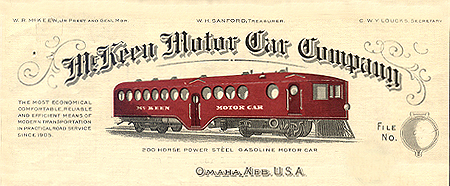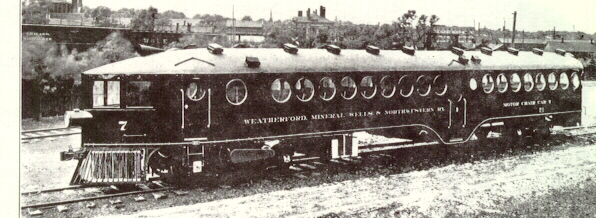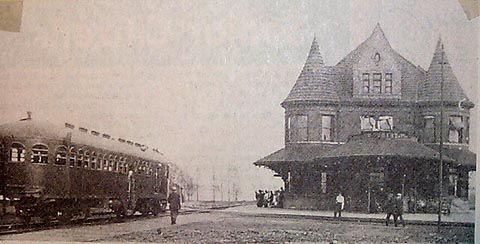McKeen Motor Car
Omaha, Nebraska
HISTORY OF THE McKEEN MOTOR CAR COMPANY


The McKeen Motor Car Company built some of the most unique motor coaches of the early part of the 20th century. William McKeen built over 150 cars between 1905 and 1917. As the Union Pacific RR, Superintendent of Motive Power and Machinery, McKeen was asked to find a way to lower passenger traffic expenses. He developed a novel design that was ahead of its time, yet did not develop with the times. Due to his close association with the Harriman lines (U.P. & S.P. and others) many of the cars were built for these railroads. The earliest models were built in U.P. shops which were eventually leased to him.



The McKeen built engine (shown above) had an air operated clutch as did the last purchased engines. Both engines were based on marine designs and proved to be unreliable. After Harriman, the railroad tycon and his mentor died, not even the U.P nor S.P. needed any new models. They had McKeens sitting all over the place, in various states of disrepair. Any railroad with these cars eventually scrapped or converted them to a better gas mechanical or gas/diesel electric drive.



Here is another view of car #3
Please Note:
All of the McKeen Motor Cars owned by the Ann Arbor (MICHIGAN)
Railroad had a different window design from the standard McKeen 'port-hole' style window.
Designed to provide more economical passenger operation than a steam powered train, gasoline motor cars were used on many smaller rail lines or branches of larger railroads.
Shown above is Ann Arbor Railroad's Gasoline Powered Motor Car No. 3 stopped at the Owosso, Michigan station in the early part of the 20th century. At one time, The Ann Arbor ran between Toledo, Ohio and Frankfort, Michigan. It used McKeen Motor Cars for passenger service and light freight and mail between Owosso and Cadillac for several years until that specialized service was abandoned in 1924.
The Central Michigan Railroad operated a similar motorized car between Saginaw and Lansing, with a stop in Owosso, until about the mid 1930's.
The Ann Arbor car left Owosso every morning and returned from Cadillac afternoons. This trip took four to five hours each way.

Clare Depot
Illumination was provided by gas lights, much like the carbide lamps used on automobiles. The Ann Arbor timetables noted that their cars were equipped with electric lights and electric fans! And they sometimes started the McKeens by pushing them with a steam engine.

Ann Arbor Railroad McKeen #4 at Cohoctah

William R. McKeen, Jr., Superintendent of Motive Power for the Union Pacific, in 1905 designed and built the first McKeen motor car in their shops in Omaha. In the following 3 years a number were built to supplant steam trains on lightly traveled branch lines.

In 1908 the demand had become so great that Edward H. Harriman, who controlled both the Union Pacific and Southern Pacific, financed the McKeen Motor Car Company, and production was started in an old shop building in Omaha.

Carland, Michigan, which is about 6 miles west of Owosso.

From the collection of Mark Worrall
The standard model was 55 feet in length although some 70-foot cars were built. Passenger trailers were 50 feet long and mail-baggage trailers were 31 feet. These latter cars were originally built with a 4-wheel truck, but most railroads soon rebuilt them with double trucks.
All the motor cars were built with steel bodies, pointed fronts, round backs, most had port-hole windows (not the Ann Arbor R.R.) and center entrances. Their gasoline engine was mounted crosswise in the front truck with a big flywheel protruding beyond the left-side truck frame. This engine was geared only to the front axle which had 42 inch wheels. The rear axle had 33 inch wheels. It was equipped with a chain drive, an air clutch and had a two-speed transmission.
As built by the McKeen Motor Car Company, the cars had no reverse gears, and to back up it was necessary to stop the motor and re-start it in the opposite direction after shifting the cam shaft. This proved so troublesome that most railroads installed their own reverse gears.

#3 at Clare, Michigan circa 1916
The Southern Pacific, in numbering their cars, started with No. 1 and used odd numbers for motor cars and even numbers for trailer cars, so the most distinctive numbers on any roster, No. 1 and No. 13 were both assigned to McKeen motors.
The Chicago Great Western rebuilt three of their motor cars into a name train, "The Blue Bird". This included a coach section, sleeping section and a buffet-lounge.
The Motor Cars
The motor cars were the Ann Arbor's answer to shorthaul demand for pickup along the railroad. Passengers were picked up at all road crossings from Cadillac to Toledo. They did not operate between Elberta and Cadillac because of the hills which were too steep and heated the engines.
They were built by McKeen Motor Car Company of Omaha, Nebraska. George Croker, father-in-law of William Draper, went west and brought them to Ann Arbor one by one. They were discontinued in 1920 because of loss of business brought about by the automobile.
While these motorcars did not operate into Elberta except on two or three test runs, they show that the Ann Arbor people were always promoters.
Dr. Daniel Wm. McClary, J.D. submits the following:
I worked on the AARR as a brakeman in 1969 and at the Milan Tower (AA/NW) in 1970. I am a current member and former board member of the Ann Arbor Railroad Technical and Historical Association.
The AARR had five McKeen Cars #1-5. The first car, #1 arrived the first week of May, l911. The other 4 cars; #2, #3 and #4 arrived in the next 2 months of 1911. The last McKeen car was removed from service December 31, 1924.


In 1917, the AARR switched to kerosene which was then becoming cheaper than gasoline. He indicated that all five cars were converted at that time. I asked him how the cars were started then. He said that they added a small fuel tank that still had gasoline and the main fuel tank used the kerosene after conversion. The engines had six pistons and if enough air was left in the main air reservoir, that air was injected into three pistons to get the engine spinning over. Then, gasoline from the small extra fuel tank added on was put into the other three pistons until they fired.
Once the engine was firing on gasoline and warmed up, it then was shunted over to the main fuel tank of kerosene. He said that if the main air reservoir was depleted, they either used shop air with a hose or pushed the McKeen Car down a siding next to the shop with a steam engine.
I asked him if the cars were ever converted to electric lights and he said no! They originally came with acytlelene arc lights. He says they remained that way until the end. Tanks were mounted crosswise under the McKeen car at the rounded rear end. They put a wooden ramp between the rails that went up under the back end of the car to roll out the old tanks and roll up the new tanks. The old tanks and new tanks were all rolled down the tops of the rail to and from the shop. The tanks were strapped up under the car.

Circa 1911 at Farwell, Michigan
The information I have indicates that there were McKeen Motor Car single stall houses built in Ann Arbor, Michigan, (I have a map indicating its location but no photo), and Howell, Michigan. They were also stored in the roundhouse at Toledo, in the backend of the old passenger car shop at Owosso and at Selma Yard roundhouse in Cadillac (I have maps showing an extra stall added to the Selma roundhouse just after 1911 which presumably was added for the McKeen cars.
The usual procedure was to use 4 McKeen Motor Cars at any one time, leaving one car as a spare or for shop repair time. I have newspaper timetables that show in the summer of 1911 a two car schedule and later from AARR timetables I have graphed out charts for the different routes for all four regular routes. These routes varied year to year with some out and back routes and other times with progressive rotation such as from Owosso to Toledo to Howell and stay overnight at Howell.

For instance, one car would start at Ann Arbor north to Owosso, and back to Toledo. While another would run from Howell to Toledo to Owosso, etc. The Howell McKeen Motor Car single stall engine house burned down in Howell and was never rebuilt. Afterward, the rotation schedules were modified without a layover in Howell.
Not all McKeen Cars were manufactured with round "porthole" style windows. Most were due to the "unibody" style of construction. However, McKeen also offered to build the cars in "traditional" lift windows and although rare, that is the style of windows the AARR ordered. Note the photos of the AARR McKeens. They all have arch topped lift windows and not the standard portholes. Unfortunately, Mr. McKeen was somewhat flamboyant and quite a showman. His 1912 catalog (I have a reprint of it) featured a doctored photo of a standard porthole McKeen with large "Ann Arbor" oversized lettering in the wrong place under the porthole windows. This was done to get the catalog out in time, hyping the sale of cars to the AARR. He apparently didn't have a photo of the actual AARR cars or they were not completed yet when he put out his "1912" catalog.
The 5 AARR McKeens obviously had the arch topped lift windows and lettering up above the windows. Unfortunately, his fake AARR McKeen in his 1912 catalog has caused some confusion over the years.
I have traced the AARR McKeen Motor Cars routes through timetables I have. However, I have only traced their routes until 1920. I do not have copies of the AARR time tables from 1921 - 1924 to complete my charting of their routes during the declining years of their usage (due to competition from automobiles).



The 70 footer also came in a variety of floor plans.
The standard all passenger model seated 105.

Union Pacific McKeen cars that were repowered by EMC in the late 1920s.
Photo shows what looks
like a train of two power cars
and two trailers coupled together.
Electric Powered Interurbans in Shiawassee County, Michigan
This personal webpage is not affiliated with any company listed above.